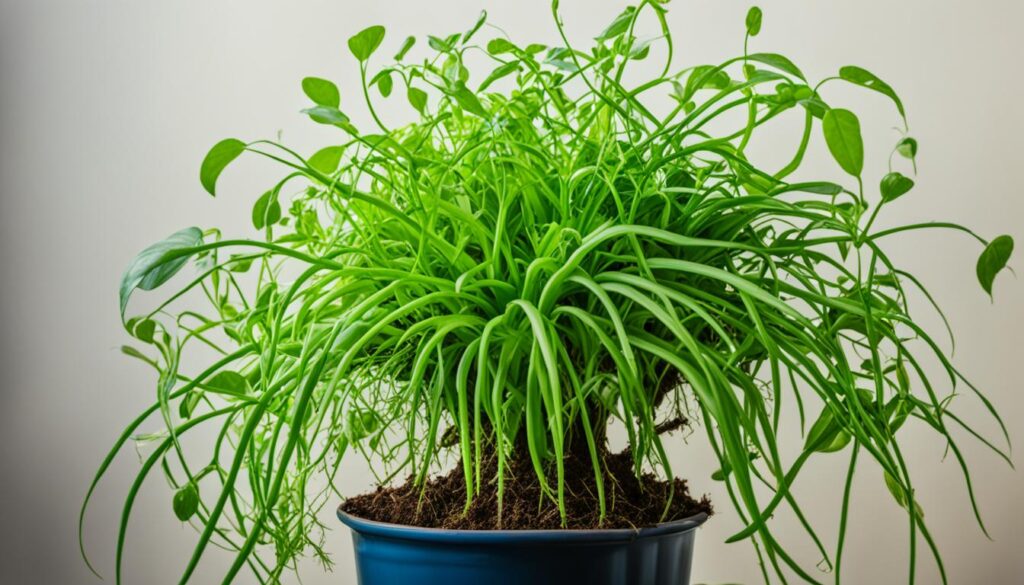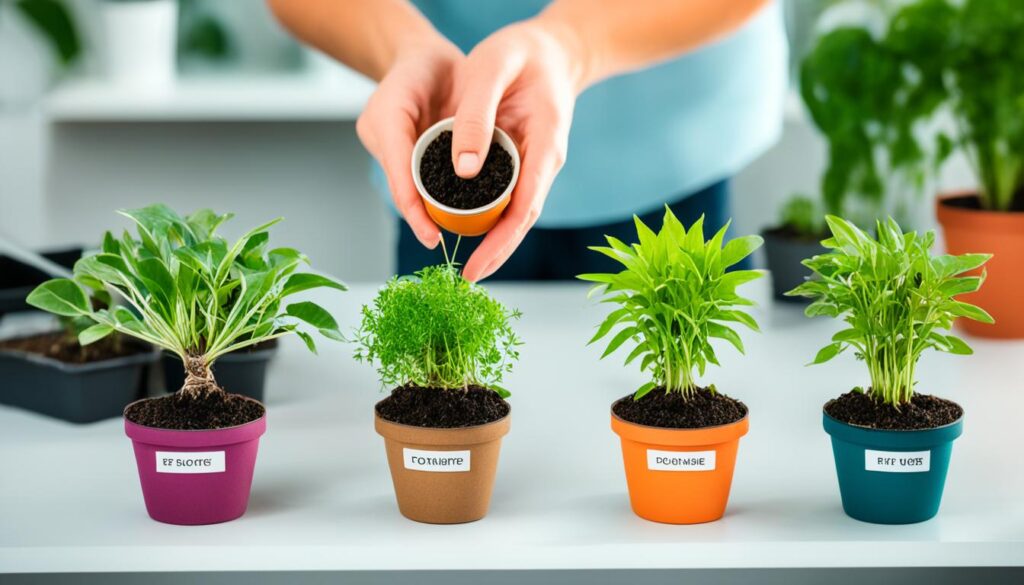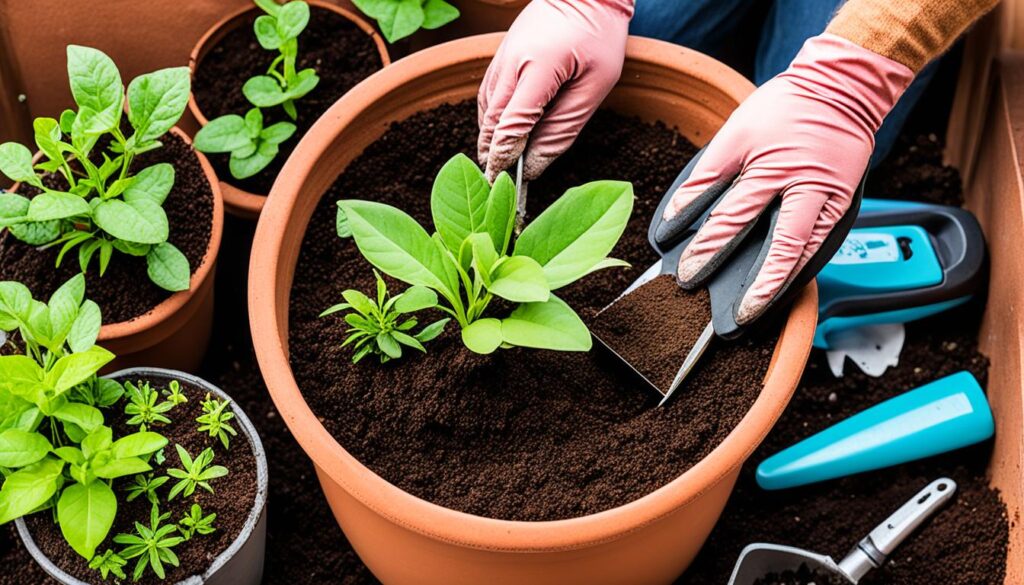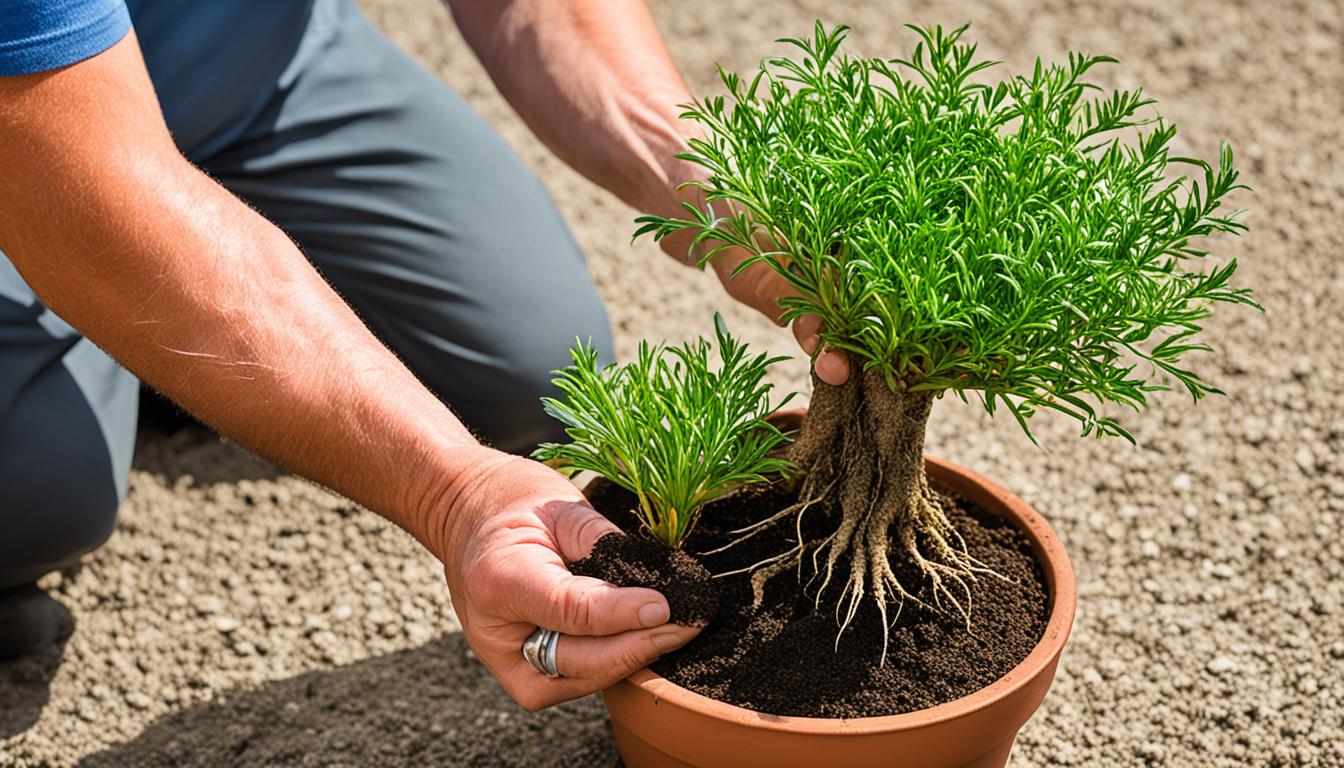Is your beloved houseplant looking a little cramped and unhappy? Could it be time for a change of scenery? Discover the art of repotting and give your indoor plants the room they need to flourish!
Repotting is an essential practice for the growth and health of indoor plants. Most houseplants require repotting every one to two years, while some may need it more frequently. Repotting allows plants to have ample space for their roots to grow and access fresh nutrients from new potting soil.
Choosing the right pots and potting mix is crucial for successful repotting. It’s important to use pots with drainage holes, as they prevent waterlogging and root rot. Different plants have unique potting mix requirements, so selecting the appropriate potting soil is essential for their well-being.
In this article, we will guide you through the art of repotting indoor plants. From recognizing the signs that your plant needs repotting to the step-by-step process of repotting and caring for your plants afterward, we will equip you with the knowledge to ensure your indoor plants thrive.
Key Takeaways:
- Repotting is essential for the growth and health of indoor plants.
- Most houseplants need repotting every one to two years.
- Signs that your plant needs repotting include roots poking out of drainage holes and struggling for space in its pot.
- Choose pots with drainage holes and select the appropriate potting mix for your specific plant.
- Proper aftercare, including watering and lighting, is crucial for the recovery of repotted plants.
Introduction
Welcome to the world of indoor gardening! Repotting your houseplants is an essential part of their care routine that ensures their growth and overall health. By providing your plants with the appropriate potting mix, pot size, and proper aftercare, you can help them thrive and beautify your living space. In this section, we will delve into the process of repotting and explore the signs that indicate it’s time to repot your houseplants. So let’s get started on this exciting journey of nurturing your indoor foliage companions!
Repotting your houseplants not only allows them to grow and develop better, but it also provides you with an opportunity to inspect the roots and ensure that they are healthy. Whether you are an experienced gardener or a beginner, this section will equip you with the knowledge to recognize the signs that indicate your plant needs repotting. By understanding these signs, you can take timely action and provide your plants with the space they need to thrive.
Signs It’s Time to Repot
Recognizing the Signs
As a plant enthusiast, it’s important to pay attention to the signs that indicate your houseplants need repotting. These signs serve as valuable indicators that your plants are outgrowing their current pots and need more space to thrive. By recognizing these signs early on, you can ensure the health and vitality of your indoor garden.
Signs of Root-Bound Plants:
One of the key signs that your plant needs repotting is when you see roots poking out of the drainage holes at the bottom of the pot. This indicates that the roots have filled up the entire pot and are in desperate need of more space. Additionally, if you notice coiled roots on the soil surface or roots circling around the inside edges of the pot, it’s a clear indication that your plant is root-bound and in need of a larger container.
Signs of Struggling Plants:
Another sign that your plant requires repotting is when it starts to exhibit signs of struggling. Look out for stunted growth, where your plant fails to show any significant growth despite being regularly cared for. Yellowing leaves can also be an indication of root congestion, as the plant’s ability to uptake nutrients becomes compromised. Furthermore, if you notice a thick mat of roots on the soil surface, it’s a sign that your plant is struggling and needs repotting to continue flourishing.
Before deciding to repot your plant, carefully assess its overall health and condition. Some signs of struggling can also be attributed to other factors such as incorrect watering, lighting, or pest infestations. Therefore, make sure to rule out any other issues before concluding that it’s time for a repotting session.

| Signs It’s Time to Repot | |
|---|---|
| Signs of Root-Bound Plants | Signs of Struggling Plants |
| – Roots poking out of drainage holes | – Stunted growth |
| – Coiled roots on the soil surface | – Yellowing leaves |
| – Roots circling around the inside edges of the pot | – Thick mat of roots on the soil surface |
Choosing the Right Pot
Factors to Consider
When it comes to repotting your houseplants, choosing the right pot is crucial for their overall health and well-being. Here are some factors to consider when selecting a pot for repotting:
- Pot Size: The size of the pot plays a significant role in ensuring the optimal growth of your plant. It is important to choose a pot that provides enough space for the plant’s root system to grow without being overly spacious.
- Pot Material: There are various pot materials to choose from, including plastic, clay, ceramic, metal, and wood. Each material has its own advantages and disadvantages. Plastic pots are lightweight and affordable, while clay and ceramic pots provide better breathability for the roots. Metal pots are durable but can get hot in direct sunlight, while wood pots offer a natural aesthetic but require regular maintenance.
- Drainage Holes: Pots with drainage holes are essential for proper water drainage and preventing overwatering. Good drainage helps prevent root rot and ensures the plant’s roots receive the oxygen they need. Avoid pots without drainage holes, as they can lead to waterlogged soil and cause root problems.
When choosing pots for repotting, it is important to consider the specific needs of your plants and their growth habits. Now, let’s explore these factors in more detail:

Preparing for Repotting
Before embarking on the repotting process, it’s crucial to gather the necessary supplies and prepare your houseplant for the transition. By taking these preparatory steps, you can ensure a smooth repotting experience that promotes the health and growth of your indoor plants.
Gathering Supplies
To execute a successful repotting, you’ll need a few essential supplies. Here’s a checklist of items to have on hand:
- Appropriate Potting Mix: Choose a high-quality potting mix suitable for your specific plant type.
- New Pot: Select a pot that is one size larger than the current one, allowing adequate space for root growth.
- Gardening Gloves: Protect your hands with a sturdy pair of gloves to avoid any injuries during the process.
- Hand Trowel: A hand trowel is essential for loosening the soil and maneuvering the plant during repotting.
Preparing the Plant
Prior to repotting, it’s important to take a couple of crucial steps to ensure the plant is ready for the transition.
Firstly, water the plant thoroughly 24 hours before the scheduled repotting. Adequate hydration helps loosen the soil and facilitates the removal of the plant from its current pot. However, be mindful not to overwater, as overly saturated soil can make the process messy and potentially harm the roots.
Before removing the plant from its pot, inspect the roots carefully. Look for any signs of pests or diseases and address the issue accordingly. Additionally, check for any circling or tangled roots that need pruning before repotting.
By gathering the right supplies and properly preparing your plants, you can ensure a successful and stress-free repotting process. Remember to take your time and handle the plants with care, providing them with the optimal conditions they need to thrive.

The Repotting Process
Step-by-Step Guide
Proper repotting techniques for indoor plants are essential to ensure their growth and vitality. Follow these step-by-step instructions to repot your houseplants effectively:
1. Loosen the soil: Gently tap the sides and bottom of the pot to loosen the soil. This helps in easy removal of the plant’s root ball.
2. Spread the roots: Carefully separate any tangled or compacted roots, allowing them to spread naturally in the new pot. This promotes healthy growth.
3. Fill the pot with soil: Place the plant in the center of the new pot and fill the space around the edges with fresh potting soil. Ensure that the soil level is slightly below the rim of the pot.
4. Proper watering: After repotting, water the plant thoroughly until water drains out of the bottom of the pot. This helps settle the soil and ensures proper hydration for the plant.
By following these repotting steps, you can provide a conducive environment for your indoor plants’ growth and help them thrive in their new pots.
Aftercare and Recovery
Proper aftercare and recovery are crucial for the well-being of your repotted houseplants. After repotting, your plants need time to adjust to their new pot and environment. Follow these tips to ensure a smooth transition and support their growth:
Caring for Repotted Houseplants
- Give your plants time to adjust: After repotting, your plants may experience some stress. Allow them a few days to settle into their new pot before introducing any major changes.
- Proper watering: It’s important to water your repotted plants appropriately. Avoid overwatering, as the new potting mix may retain more moisture than the previous one. Monitor the soil moisture and adjust your watering schedule accordingly.
- Optimal lighting conditions: Place your repotted plants in a suitable location with appropriate lighting conditions. Some plants may require more or less light after repotting, so be mindful of their specific needs.
- Avoid overfertilization: During the recovery period, it’s best to hold off on fertilizing your plants. The fresh potting mix may already contain nutrients, and overfertilization can lead to nutrient burn or other issues. Wait a few weeks before resuming your regular fertilization routine.
By providing proper aftercare and allowing your plants to recover, you’ll help them thrive in their new pot and ensure their overall health and growth.
Special Considerations
Repotting Large Indoor Plants and Unique Species
When it comes to repotting houseplants, special considerations are required for larger indoor plants and unique species. These plants may have specific needs that differ from regular houseplants, and understanding these requirements is crucial for their successful repotting.
One important factor to consider when repotting large indoor plants is root pruning. These plants often have extensive root systems that can become overcrowded, affecting their overall health. By carefully pruning the roots during repotting, you can promote better growth and prevent root-bound conditions.
For unique plant species such as orchids, a different approach is necessary. When repotting orchids, it is essential to remove any compressed coir plugs and transfer them to clear plastic pots. This allows for proper aeration and moisture control, which are crucial for these delicate plants.
Another unique group of plants that require special attention during repotting are carnivorous plants. These fascinating plants have specific soil requirements and nutrient preferences. It is recommended to use low-nutrient ericaceous potting medium when repotting carnivorous plants to ensure their health and well-being.
Repotting citrus plants also requires specialized care. These plants thrive in loam-based compost that provides optimal drainage while retaining sufficient moisture for fruit formation. By using the right compost and maintaining proper watering practices, you can ensure the success of repotting citrus plants.
With these special considerations in mind, you can confidently tackle the repotting process for larger indoor plants and unique species. Remember to research specific plant requirements, follow proper techniques, and provide the necessary care post-repotting to ensure the health and vitality of your beloved houseplants.
Conclusion
Repotting your indoor plants is a crucial step in ensuring their growth and overall health. Throughout this article, we have discussed the importance of repotting houseplants, signs that indicate it’s time to repot, choosing the right pot, preparing for the repotting process, the step-by-step guide to repotting, and aftercare and recovery. By following these tips and techniques, you can achieve healthier and happier houseplants.
Regular repotting allows your plants to have adequate space for root growth, prevents them from becoming root-bound, and encourages better nutrient uptake. It’s essential to pay attention to the signs, such as roots poking out of drainage holes or struggling for space, indicating that a plant needs repotting.
When repotting, choose pots with drainage holes to ensure proper water drainage and avoid overwatering. Consider the appropriate pot size based on your plant’s root system, and use a suitable potting mix. Whether it’s a general houseplant repotting mix or a specialist mix for specific plant groups, using the right compost is crucial.
After repotting, give your plants the care they need to recover and thrive. Proper watering, lighting, and avoiding overfertilization are essential for their well-being. By following these guidelines and staying attentive to your plant’s needs, you can achieve healthier houseplants that will bring beauty and freshness to your indoor space.
FAQ
Why is repotting indoor plants important?
Repotting indoor plants is important for their growth and health. It allows the plant to have fresh soil, provides more space for the roots to grow, and helps prevent root-bound conditions.
How often should I repot my houseplants?
Most houseplants need to be repotted every one to two years. However, some plants may require more frequent repotting, while others may need repotting less often.
What is the best time to repot houseplants?
The best time to repot houseplants is during their active growth period, typically in the spring or early summer. This allows the plant to recover quickly from the repotting process and take advantage of the growing season.
What are the signs that indicate a plant needs repotting?
There are several signs that indicate a plant needs repotting, such as roots poking out of drainage holes, roots coiled on the soil surface, stunted growth, struggling for space in its pot, and yellowing leaves.
Do I need to use pots with drainage holes?
Yes, it is crucial to use pots with drainage holes for repotting indoor plants. Drainage holes allow excess water to escape, preventing overwatering and potential root rot.
What factors should I consider when choosing a pot for repotting?
When choosing a pot for repotting, consider the appropriate pot size based on the plant’s root system. Also, consider the pot material, such as plastic, clay, ceramic, metal, or wood, each with its pros and cons.
How should I prepare for repotting my houseplants?
To prepare for repotting, gather supplies such as the appropriate potting mix, a new pot of suitable size, gardening gloves, and a hand trowel. Additionally, water the plant 24 hours before repotting to ease removal from the pot.
What is the process of repotting indoor plants?
The process of repotting indoor plants involves loosening the soil around the plant’s root ball, gently spreading the roots in the new pot, filling the pot with fresh potting soil, and proper watering after repotting.
How should I care for my houseplants after repotting?
After repotting, it is important to ensure your houseplants adjust to their new pot by providing proper watering and lighting. Avoid overfertilization during the recovery period and monitor the plant’s overall health and condition.
Are there any special considerations for repotting large indoor plants?
Yes, repotting large indoor plants may require root pruning and choosing suitable pot sizes to accommodate the plant’s size and root system. It is important to carefully balance the plant’s weight and stability.
What are the specific requirements for repotting orchids?
Repotting orchids involves removing compressed coir plugs, using clear plastic pots to allow light to the roots, and choosing specialized orchid potting mix to support their growth and drainage needs.
Can you give an example of a specialist compost for repotting carnivorous plants?
Yes, for repotting carnivorous plants, a low-nutrient ericaceous potting medium is recommended. This specialized compost provides the right conditions for these unique plants to thrive.
What type of potting mix should I use for repotting citrus plants?
Repotting citrus plants requires a loam-based compost mix that provides excellent drainage and nutrient availability. This type of potting mix supports optimal fruit formation in citrus plants.




Pingback: Orchid, The Elegant, Low-Maintenance Flowering Plant for a Touch of Luxury